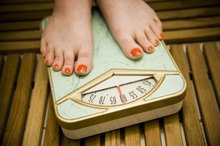What does fact checked mean?
At Healthfully, we strive to deliver objective content that is accurate and up-to-date. Our team periodically reviews articles in order to ensure content quality. The sources cited below consist of evidence from peer-reviewed journals, prominent medical organizations, academic associations, and government data.
- National Heart, Lung and Blood Institute: Balance Food and Activity
- National Heart, Lung and Blood Institute: Balance Food and Activity
- Centers for Disease Control and Prevention: Childhood Obesity
The information contained on this site is for informational purposes only, and should not be used as a substitute for the advice of a professional health care provider. Please check with the appropriate physician regarding health questions and concerns. Although we strive to deliver accurate and up-to-date information, no guarantee to that effect is made.
Diet & Exercises for a 7-Year-Old
If you're the busy parent of a growing 7-year-old, providing the nutrients she needs and finding opportunities for physical activity can be a balancing act. Yet your child depends on you to equip her with the tools necessary for a healthy lifestyle. According to the Centers for Disease Control and Prevention, the prevalence of obesity in children ages 6 to 11 rose from 6.5 percent in 1980 to 19.5 percent in 2008 13. If your child is becoming overweight, now is the time to address the problem.
Energy Balance
The National Heart, Lung and Blood Institute refers to the relationship between calorie consumption and expenditure as energy balance 2. Managing your calories is similar to balancing your checking account. When you write a check, you must be certain the funds are available in your bank account if you want to avoid the costly consequences of insufficient funds. Similarly, when you consume a certain food, your physical activity must be adequate to offset the extra calories, or you will suffer negative consequences in the way of excess body fat. A moderately active 7-year-old needs 1,400 to 1,600 calories daily for healthy growth and development, according to the institute.
- The National Heart, Lung and Blood Institute refers to the relationship between calorie consumption and expenditure as energy balance 2.
- When you write a check, you must be certain the funds are available in your bank account if you want to avoid the costly consequences of insufficient funds.
Nutrition Basics
How to Boost the Immune System in Teenagers
Learn More
Monitoring your child's calories may be difficult, but changing dietary options will eliminate some of the guesswork. While quick and convenient, processed and fast foods are calorie-packed and loaded with sugar, fat and sodium. These foods fall short of meeting your child's needs for vitamins, minerals and fiber. Fresh fruits and vegetables are rich in nutrients and low in calories. Fortified nonfat milk provides calcium, protein and vitamin D for healthy bone and muscle development. The U.S. Department of Agriculture's MyPyramid for Kids advocates a diet rich in whole grains, fresh fruits and vegetables, low-fat dairy and lean protein.
- Monitoring your child's calories may be difficult, but changing dietary options will eliminate some of the guesswork.
- The U.S. Department of Agriculture's MyPyramid for Kids advocates a diet rich in whole grains, fresh fruits and vegetables, low-fat dairy and lean protein.
Physical Activity
The Centers for Disease Control and Prevention recommends at least 60 minutes of physical activity daily for children and teens 13. Most of that 60 minutes should consist of moderate to vigorous aerobic activity like brisk walking, running, cycling, swimming or other energetic whole-body exercise. The CDC encourages muscle-building activity like push-ups or gymnastics three times per week and weight-bearing activity that builds bone density like jumping rope and running at least three days per week. If your child is overweight, extra activity may be needed to burn excess body fat.
- The Centers for Disease Control and Prevention recommends at least 60 minutes of physical activity daily for children and teens 1.
- The CDC encourages muscle-building activity like push-ups or gymnastics three times per week and weight-bearing activity that builds bone density like jumping rope and running at least three days per week.
Taking Charge of Your Child's Health
How to Lose Belly Fat Fast for Kids
Learn More
As a parent, it is up to you to set your child on the path to a healthy lifestyle. Centering family time on physical activities like cycling, swimming or a trip to the neighborhood playground allows you and your child to forge a meaningful relationship while engaging in healthful behaviors. Keep fresh fruits and vegetables handy for quick snacks, and purge your refrigerator and cabinets of soda, cookies, chips and ice cream. Most of all, set an example by cleaning up your own diet and engaging in daily exercise.
- As a parent, it is up to you to set your child on the path to a healthy lifestyle.
- Centering family time on physical activities like cycling, swimming or a trip to the neighborhood playground allows you and your child to forge a meaningful relationship while engaging in healthful behaviors.
Related Articles
References
Writer Bio
Michelle Matte is an accomplished fitness professional who holds certifications in personal training, pilates, yoga, group exercise and senior fitness. She has developed curricula for personal trainers and group exercise instructors for an international education provider. In her spare time, Matte writes fiction and blogs.









